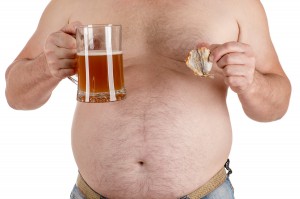Dr. Alan Bauman gave a talk about combatting hair loss. This talk was part of the 26th Anti-Aging Conference of the American Academy of Anti-Aging Medicine in Las Vegas from December 13 to15, 2018.
Dr. Bauman is the owner of many hair loss clinics around the US. Dr. Bauman said that the baldness gene is present in 4 out of 7 men. The gene codes for male alopecia, which means hair loss. We are all familiar with it. First it causes only a receding hairline in the front. Later it causes thin hair and baldness at the crown. But in later years this gene causes baldness in males. One of the metabolites of testosterone, DHT (dihydrotestosterone) causes hair follicles to miniaturize. The result is that hair is no longer covering the scalp skin as much as it used to.
Mild hair loss
In the case of mild hair loss local application of 5% Minoxidil will often make a big difference. The physician will want to order a testosterone blood level. It this is low, replacement with testosterone will restore his libido, normalize his erectile dysfunction and give him more energy. Often his hair growth will also recover to a certain extent. Together with Minoxidil 5% he may be doing well for 5 or 10 years.
But eventually the persistence of DHT as the end metabolic product of testosterone gets the upper hand and causes more hair loss.
Low-level laser therapy is another method how to re-stimulate the atrophied hair follicles to grow to full hair again. Dr. Bauman showed amazing before and after images that documented vigorous new hair growth with low-level laser therapy.
Moderate hair loss
Those men who have the baldness gene will experience more severe hair loss by the age of 30 to 40. More effective methods are necessary to help him. Oral finasteride is one medication the doctor can prescribe. But one of the side effects can be a decrease in libido, which many men will not like. But the patient can apply finasteride 0.25% topical to the hair. This reduces systemic side effects, but helps the hair to grow. Minoxidil 5% can be combined with topical finasteride.
Platelet rich plasma
One step further is the use of platelet rich plasma. Blood is collected from the patient. A dual-spin procedure produces platelet rich plasma. This was tested in the laboratory and showed about 7-fold the amount of lymphocytes, 3-times the amount of monocytes and 6.3-fold more platelets than whole blood. This PRP preparation is injected into the areas where hair growth is missing. If there are still atrophied hair follicles present in the scalp, lush new hair growth will develop following PRP injections. The effect of the PRP injections can also increase by additional low-level laser therapy. PRP is especially useful for the treatment of alopecia areata, which otherwise would be difficult to treat. To a certain degree PRP injections will also serve a male well that has androgenic hair loss.
Severe hair loss
When a male with the baldness gene enters the late 50’s or 60’s there may no longer be viable atrophied hair follicles present in the bald areas. This is when you have to make a decision whether to shave your whole head and embrace baldness or whether you are using the more expensive hair transplant method. The occipital hair, even in bald people is not responding to DHT. This is why occipital hair is the ideal donator site for a hair transplant. This consists of harvesting DHT-resistant hair follicles from the occipital scalp and transplanting them into the areas that are in need to be cosmetically improved. It is a time consuming procedure, transplanting one follicle at a time.
Hair transplant
The technique is either manual transplantation or robotic-assisted hair transplant surgery. As only parts of the occipital hair follicles are useful material, there is no scar or baldness from the surgery. In 7 days the occipital area has healed over. A man may require 3 or 4 hair transplants in a lifetime to cover up areas of the scalp that were balding because of the baldness gene. But the end result is natural looking hair that now is resistant to DHT as it was transplanted from the occipital scalp. A total of four hair transplants are possible without denuding the scalp region. Dr. Bauman showed many before and after photos of men who had hair transplants.
Conclusion
Hair loss is common, perhaps more so in men than in women. However, in both cases a lot of therapeutic approaches are possible. Milder hair loss responds to treatment with Minoxidil 5%. In addition finasteride in a local 0.25% topical application is a choice. When hair loss is more severe, PRP (platelet rich plasma) injections into the scalp area are a possibility, but only where viable, but atrophied hair follicles are not growing enough hair. This may give a very acceptable result.
But the aging male who has genetic baldness working against him needs to consider a hair transplant with DHT resistant hair follicles from the occipital scalp into the bald areas.
The beauty is that there is a solution for every one. Due to extensive research of the various methods you can trust that they will give you the results you want.















